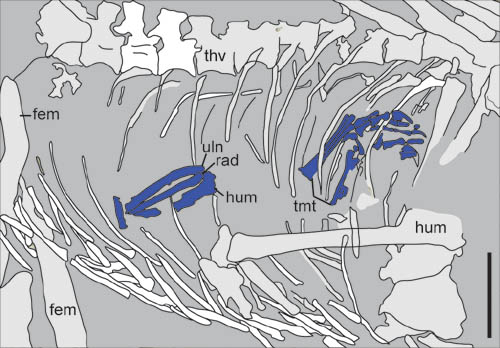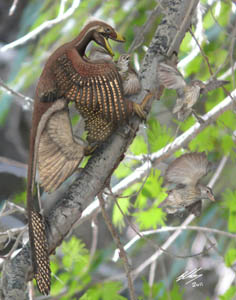Microraptor Feeding
Microraptor gui, with aerodynamic flight surfaces on its fore and hind limbs, has been at the center of discussions regarding the evolution of flight among dinosaurs since its initial discovery. However, the ecology of this taxon, whether primarily arboreal or cursorial, is controversial, and the two-dimensional, crushed bones are incapable of answering questions regarding degree of hind limb abduction or posture, which might otherwise provide clues to how the animal was living. However, this new specimen of Microraptor preserves new evidence to contribute to the debate. The bird preserved in the stomach of this specimen is a member of the clade Enantiornithes; in the Jehol, enantiornithines display arboreal adaptations relative to other avian groups, such as distally located first pedal digit, distal pedal phalanges elongated relative to proximal phalanges, and large recurved pedal claws. Furthermore, the bird is represented by the articulated partial skeleton, suggesting it was not scavenged, in which case you would imagine the specimen to be much more fragmentary and disarticulated, but actively hunted and captured. The ability to hunt and capture an adult bird in an arboreal environment suggests Microraptor was an agile predator. “Although this new specimen does not mean without a doubt Microraptor was indeed arboreal or restricted to this environment,” says Dr. O’Connor, “it is suggestive of this hypothesis and contributes new evidence to this important debate.”
Jingmai O'Connor, Zhonghe Zhou, Xing Xu. 2011. Additional specimen of Microraptor provides unique evidence of dinosaurs preying on birds. Proceedings of the National Academy of Sciences. http://www.pnas.org/content/early/2011/11/17/1117727108.abstract

Fig. 1. Photograph (A) and camera lucida drawing (B) of the new Microraptor gui specimen IVPP V17972A. (Image by Dr. ZHOU Zhonghe)

Fig. 2. Close up of the abdomen of the new Microraptor; the remains of the enantiornithine bird are indicated by blue.(Image by Dr. ZHOU Zhonghe)

Fig. 3. Reconstruction of the feeding habits of Microraptor. (Image by Brian Choo)
Download attachments: